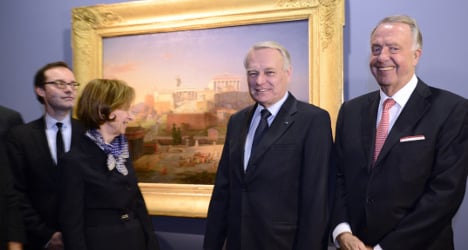The German media has called the issue a "cultural-political scandal." The exhibition, which covers art from 1800 to 1939 – with works of painters like Caspar David Friedrich and Max Beckmann to a clip film by Third Reich director Leni Reifenstahl – has been accused of portraying a "German Sonderweg" through its art.
The Sonderweg is a controversial theory which says that Germany developed distinctively differently from other western nations, which led directly to the birth and rise of National Socialism in the country.
German daily Frankfurter Allgemeine Zeitung accused the French museum of "weaving its own version of Germany's history," a version that "endorses all the clichés of a romantically-unknown, dangerous and dark neighbouring country."
"We are completely surprised and taken aback by the intensity of the attack on the exhibition," said the museum's management in a statement.
The exhibition, titled "De l’Allemagne, 1800-1939. German Thought and Painting, from Friedrich to Beckmann" and featuring 200 works of art, aims at shedding light on this era of German art for the French public.
"Through art, we will understand our German friends better", French Prime Minister Jean-Marc Ayrault had commented at the exhibition inauguration at the end of March.
People who criticised the exhibition referred to comments made by Andreas Beyer, co-curator of the exhibition and Director of the German Centre for the History of Art in Paris. Beyer complained that the discourse on the project was becoming "increasingly national" and that the Louvre is showing "a teleologically oriented history of the development of Germany" in the German weekly newspaper Die Zeit.
Most people are asking why Beyer didn't distance himself from the exhibition if it was falsely interpreted.
"We are dumbfounded. Beyer was there for all the previews, was given all the documents to read and contributed to the catalogue," said the museum's management.
The press-material states that the exhibition was initiated by the German Centre for the History of Art in Paris. It was, however, organized by the Louvre. Beyer is said to have approached the museum with a project originally meant to display about 30 works of art about Weimar in the 19th century.
"We wanted to have a big German exhibition related to art in the 19th century which is not well known in France," said the museum authorities. "It is a joint scientific collaboration which is reflected in the catalogue and in the colloquia."
Beyer had remained reserved in his comments before the opening. He is said to have believed that even though everything hadn't gone according to the way he had imagined, the quality of the pieces would be convincing enough.
"We want to show that the German art of the 19th century is not burdened by theory, that it did not pursue a path to the Sonderweg, but that it is simply just happens to be different," Beyer had said at the time.
Regardless of the dispute, the exhibition has caught on very well with the French. According to the museum, it has seen about 3,400 visitors daily in its first two weeks. This is much more than what was expected, making the exhibition one of the most visited in the Louvre's history. The exhibition runs till June 24th.
DPA/The Local/mb
This article first appeared in The Local Germany



 Please whitelist us to continue reading.
Please whitelist us to continue reading.
Member comments